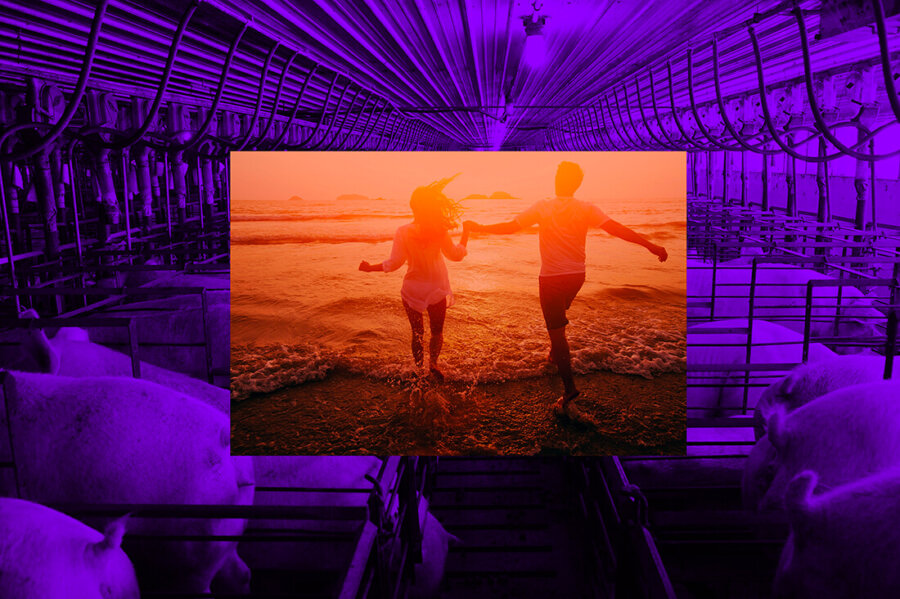
Online creation
WELCOME TO EREWHON
A project by Pierre Cassou-Noguès, Stéphane Degoutin and Gwenola Wagon
From 18 December 2018 to 06 June 2019
Jeu de Paume – Online
Welcome to Erewhon will be published in bi-monthly episodes. Each episode will develop on a specific theme and will be accompanied by a text that can be accessed from the platform.
Erewhon 1872
Welcome to Erewhon is an adaptation of Samuel Butler’s visionary novel Erewhon, published in 1872, in which he speculates about an imaginary country and in so doing, pushes our way of attributing meaning to the world to the very limits of its logic.
In his book, Butler maintains that he has discovered a previously unknown land that is cut off from the rest of the world. It is called Erewhon (an anagram of “Nowhere”). At first sight, the Erewhonians seem hospitable, however the explorer notices that their customs are strange and that they obey stringent rules. For example, it is forbidden to kill animals for food and you may only eat vegetables that let you do so; people attend “Colleges of Unreason” and show no pity for the sick whom they treat as criminals. Above all, the use of machines is strictly forbidden. The explorer is even put in prison when he takes his watch out of his pocket. It is there that he discovers the “Book of Machines” that, some five centuries before, had caused a revolution during which the Erewhonians destroyed all their mechanical inventions. The Erewhonians believe that machines evolve in much the same way as living species and comprise a separate kingdom to the animal and plant kingdoms. Even if they are not endowed with human consciousness or animal life, machines evolve to adapt to the environment and the living creatures they are in contact with.
Erewhon 2018
One hundred and fifty years after Samuel Butler’s initial voyage, Erewhon has changed a lot. Automatisation has been taken to the limit and work as we know it has disappeared. Factories produce all of life’s necessities. Production, storage and handling are outsourced to warehouses outside of town, where there are no humans. Farms rear animals, grow crops and transform the produce. Vehicles deliver it. Software programmes optimise the system.
The inhabitants have been rid of any exacting activities and are free to devote themselves to the pursuit of pleasure. They have made a selection so that the only machines that remain close-by are those that afford them a measure of wellbeing; the others are relegated to the periphery. Humankind now only works to develop and extend its leisure activities and childhood lasts much longer.
Robot otters take care of the elderly and purr following the instructions of their AI, whereas other robots are in charge of massaging inhabitants and preparing their meals. GPS-equipped cats map out the surrounding areas; robotic vacuum cleaners discover sensuality and pigs with augmented brains are connected in a network.
The city behind the screen
The brains of humans, animals and plants are linked together in equal measure as part of an interconnected data centre system that processes all thoughts. This network also conserves the city’s memory. Algorithms can allow the dead to speak again, which is how the spirit of Samuel Butler can once more wander amongst images of the city. One hundred and fifty years after his first visit, Samuel Butler returns to Erewhon and, from behind the screen, comments on images found on Internet.
Stéphane Degoutin and Gwenola Wagon
Faced with a world they do not take for granted, artists Stéphane Degoutin and Gwenola Wagon speculate on potential alternatives with films, essays and installations. They fight against the planned obsolescence of man (Cyborgs in the Mist), advocate for the end of work (Neoteny Institute), denounce the automation of the processing of products, life and data (The World as an Automated Warehouse), observe the private reticulation of public space (Voluntary Prisoners of the American Dream), investigate the places where the Internet is processed and stored (Globodrome, World Brain), experiment alternative lifestyles for an hyperinformation society (Controlled Schizophrenia Laboratory), ask researchers to live in the forest, naked but connected to the network (Wiki Forest), collect images of dancing soldiers (Dance Party in Iraq), they carry out a vivisection of the international airports (Terrorism Museum, Psychoanalysis of the International Airport) and observe the transmutation of human into powder (Society as Cloud). Stéphane Degoutin teaches at the École nationale supérieure des arts décoratifs in Paris. Gwenola Wagon teaches at the University of Paris 8 in Saint-Denis.
Pierre Cassou-Noguès
Pierre Cassou-Noguès, philosopher and professor at the Department of Philosophy of the University Paris 8, co-editor of the journal SubStance (John Hopkins Univ Press). After parallel studies in mathematics and philosophy at the ENS Paris, he defended a thesis in philosophy. His recent work questions the imaginary part of scientific reason. His texts combine fiction and theory. He has published Les Démons de Gödel (Seuil, 2007), Mon zombie et moi (Seuil, 2010), Lire le cerveau (Seuil, 2011), Les Rêves cybernétiques de Norbert Wiener (Seuil, 2014).
